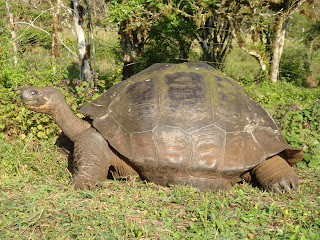 During the night we had our longest navigation of the trip, around 10 hours. The reason? We had to get all the way from Punta Vicenta Roca to Puerto Ayora on the southern shore of Santa Cruz Island. Puerto Ayora is the most important harbour in the Galapagos and the most populated town.
During the night we had our longest navigation of the trip, around 10 hours. The reason? We had to get all the way from Punta Vicenta Roca to Puerto Ayora on the southern shore of Santa Cruz Island. Puerto Ayora is the most important harbour in the Galapagos and the most populated town. Today was to be a day devoted entirely to tortoises, a creature we had not yet seen on our voyage. We started at the Charles Darwin Research Station (CDRS). First stop - the tortoise nursery. There were hundreds of little baby tortoises (needless to say they were very cute) with coloured numbers on theirs shells. The colour of the number designated what island in the Galapagos the tortoise belonged to. Each island in the archipelago has its own sub-species of tortoise. The CDRS is trying to get the numbers back up, on each island, to where they think they should be. The most famous tortoise in the station is called Lonesome George. He is from the island of Pinta and is the last survivor of his sub-species...hence the name. Huge efforts have been made to find Georgy Boy a suitable mate but to no avail. Hopefully time is on their side as they reckon he is about 75 years old now and these fellas can live to 150 years and beyond. Incidentally, they can also go for over a year without any food or water!! But if poor old Georgy Boy croaks it then another sub-species of tortoise is gone forever.
 It was an amazing morning spent amongst these incredible creatures. There were no wardens anywhere. The trail took you right through the tortoise enclosures where you could sit, nose to nose, with 5 or 6 of these 500 lb leviathans. There were also very few people around so it was great to get an opportunity to spend some tranquil time in their company watching their mannerisms.
It was an amazing morning spent amongst these incredible creatures. There were no wardens anywhere. The trail took you right through the tortoise enclosures where you could sit, nose to nose, with 5 or 6 of these 500 lb leviathans. There were also very few people around so it was great to get an opportunity to spend some tranquil time in their company watching their mannerisms. On the way back to the ship for lunch there was an opportunity for shopping. Claire saw a really nice t-shirt but in the end we actually didn´t buy anything.
The afternoon was spent looking for tortoises in the wild. We took a 30 minute bus journey to the highlands of Santa Cruz Island and entered a private farm. We walked through the fields until we came across a scene from Jurassic Park. A large field with 10 to 15 of these gentle giants scattered around. It was as though we had stepped back in time....about 65 million years. Some were happily eating grass, some were cooling off in small ponds, and some were going somewhere...I´m not sure where. It´s amazing to think that there is a place where these creatures roam wild and free. I even got some video footage of a vermilion fly catcher (bird) resting on a tortoises back. A very rare site indeed, apparently. After taking about 1000 photos we headed back to Puerto Ayora. On the way there Claire decided that she definitely wanted that t-shirt that she had seen earlier. Only problem was that shopping time was over. The guides said there was about 15mins before the last panga left for The Eclipse. This would be fine if the shop, Lonesome George and Co., wasn´t 10 minutes away. We had to run there and back. We got back to the dock, treasured t-shirt in hand, just in time to board that last panga! Success.

Pucker up big boy, it´s your lucky day!

CDRS Entrance

Are you ready, get set, go.....

You´ve got some neck on you!

Yum Yum

Hitching a ride

Mickey Mouse or is it Dave Barry taking the Micky?!

Vermillion Flycatcher
Some Charles Darwin Facts:
Darwin´s astute observations, on the Galapagos, were to set the stage for the development of the Theory of Evolution by Natural Selection as formulated in his famous publication "The Origin of Species". He was 26 years old when he visited Galapagos on board the HMS Beagle (September - October 1835, 5 weeks in total).
"It is not the strongest of the species that survives, nor the most intelligent that survives. It is the one that is the most adaptable to change"

No comments:
Post a Comment